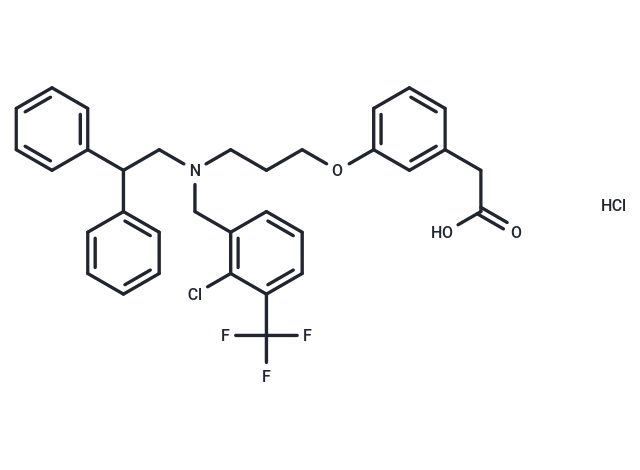Shopping Cart
Remove All Your shopping cart is currently empty
Your shopping cart is currently empty
GW3965 hydrochloride (GW3965 HCl) is an effective and specific LXR agonist for hLXRα/β (EC50: 190/30 nM).

| Pack Size | Price | USA Warehouse | Global Warehouse | Quantity |
|---|---|---|---|---|
| 2 mg | $35 | In Stock | In Stock | |
| 5 mg | $57 | In Stock | In Stock | |
| 10 mg | $90 | In Stock | In Stock | |
| 25 mg | $198 | In Stock | In Stock | |
| 50 mg | $378 | In Stock | In Stock | |
| 100 mg | $562 | In Stock | In Stock | |
| 500 mg | $1,230 | - | In Stock | |
| 1 mL x 10 mM (in DMSO) | $79 | In Stock | In Stock |
| Description | GW3965 hydrochloride (GW3965 HCl) is an effective and specific LXR agonist for hLXRα/β (EC50: 190/30 nM). |
| Targets&IC50 | LXRβ (human):30 nM (EC50), LXRα (human):190 nM (EC50) |
| In vitro | GW3965 recruits the steroid receptor coactivator 1 to human LXRα with EC50 of 125 nM in a cell-free ligand-sensing assay. [1] GW3965 shows a potent antagonistic activity against hLXRα and hLXRβ in cell-based assays with EC50 of 190 nM and 30 nM, respectively. Besides, GW3965 also sows excellent selectivity over other nuclear receptors. [1] In human islets, GW3965 (1 μM) reduces expression of selected pro-inflammatory cytokines including IL-8, monocyte chemotactic protein-1 and tissue factor. [4] |
| In vivo | In mice, GW3965 at a dose of 10 mg/kg upregulates ABCA1 expression 8-fold and raises circulating levels of HDL by 30% with Cmax of 12.7 μg/mL and t1/2 of 2 hours. [1] GW3965 (10 mg/kg) induces expression of ABCA1 and ABCG1 and shows potent antiatherogenic activity in both LDLR?/? and apoE?/? mice. [2] In male sprague-dawley rats, GW3965 reduces Ang II-mediated increases in blood pressure and decreases vascular Ang II receptor gene expression. [3] In Glioblastoma mouse model, GW3965 results in inducible degrader of LDLR-mediated LDLR degradation, increased expression of the ABCA1 cholesterol efflux transporter, and thus potently promotes tumor cell death. [5] |
| Kinase Assay | Steady-state drug accumulation assay: AuxB1 and CHrB30 cells are grown to confluency in 12-well (24 mm) tissue culture dishes and the steady-state accumulation of [3H]-vinblastine is measured. Accumulation is initiated by the addition of 0.1 μ Ci [3H]-vinblastine and unlabelled vinblastine to a final concentration of 100 nM . The accumulation of [3H]-paclitaxel is measured using 0.1 μ Ci [3H]-paclitaxel and unlabelled drug to a final concentration of 1 μM . Cells are incubated in a reaction volume of 1 mL for 60 min at 37 ℃ under 5% CO2 in order to reach steady-state. The effect of the modulators XR9576 on [3H]-ligand accumulation is investigated in the concentration range 10-9 - 10-6 M. Modulators are added from a DMSO stock giving a final solvent concentration of 0.2 % (v/v). Following cell harvesting, accumulated drug is measured by liquid scintillation counting and normalized for cell protein content. Plots of amount accumulated as a function of modulator concentration are fitted with the general dose-response equation: Y={(a-b)/(1+(X/c)d)}+b Where: Y=response; a=initial response; b=final response; c=EC50 concentration; d=slope value; X=drug concentration. |
| Cell Research | Cells are seeded in 96 wells and are treated after 24 hours with different drugs indicated in each experiment in medium containing 1% FBS or lipoprotein deficient serum. Relative proliferation is determined using Cell Proliferation Assay Kit. Cells are incubated 1.5 hrs after adding tetrazolium salt WST-1 [2-(4-iodophenyl)-3- (4-nitrophenyl)-5-(2, 4-disulfo-phenyl)-2H-tetrazolium, monosodium salt] at 5% CO2, 37oC and the absorbance of the treated and untreated cells are measured using a microplate reader at 420 to 480 nm. Cells seeded in 12 well plates are counted using a hemocytometer, and dead cells are assessed using trypan blue exclusion assays. |
| Synonyms | GW3965 HCl |
| Molecular Weight | 618.51 |
| Formula | C33H31ClF3NO3·HCl |
| Cas No. | 405911-17-3 |
| Smiles | c1ccc(cc1)C(CN(CCCOc1cccc(c1)CC(=O)O)Cc1c(c(ccc1)C(F)(F)F)Cl)c1ccccc1.Cl |
| Relative Density. | no data available |
| Storage | store at low temperature,keep away from moisture | Powder: -20°C for 3 years | In solvent: -80°C for 1 year | Shipping with blue ice/Shipping at ambient temperature. | ||||||||||||||||||||||||||||||||||||||||
| Solubility Information | DMSO: 71.2 mg/mL (115.12 mM), Sonication is recommended. Ethanol: 12.4 mg/mL (20.05 mM), Sonication is recommended. | ||||||||||||||||||||||||||||||||||||||||
| In Vivo Formulation | 10% DMSO+40% PEG300+5% Tween 80+45% Saline: 2 mg/mL (3.23 mM), Sonication is recommended. Please add the solvents sequentially, clarifying the solution as much as possible before adding the next one. Dissolve by heating and/or sonication if necessary. Working solution is recommended to be prepared and used immediately. The formulation provided above is for reference purposes only. In vivo formulations may vary and should be modified based on specific experimental conditions. | ||||||||||||||||||||||||||||||||||||||||
Solution Preparation Table | |||||||||||||||||||||||||||||||||||||||||
Ethanol/DMSO
DMSO
| |||||||||||||||||||||||||||||||||||||||||
| Size | Quantity | Unit Price | Amount | Operation |
|---|

Copyright © 2015-2026 TargetMol Chemicals Inc. All Rights Reserved.